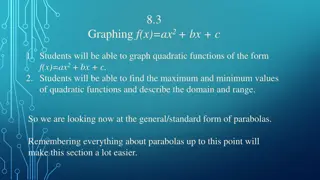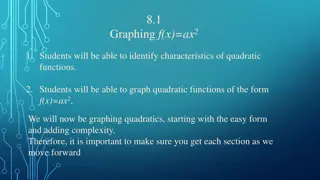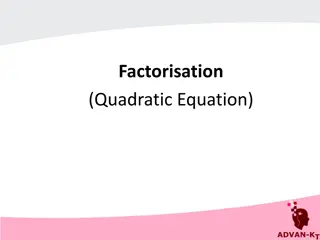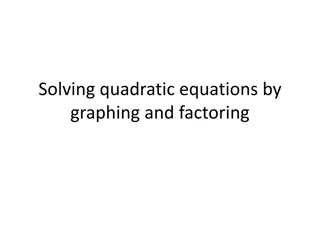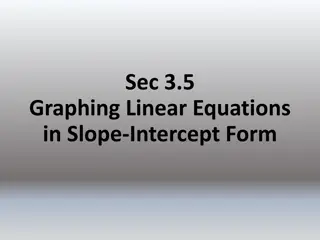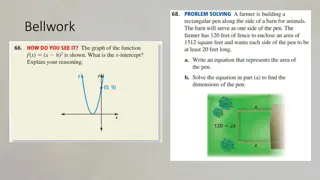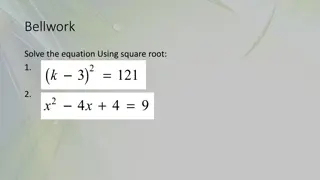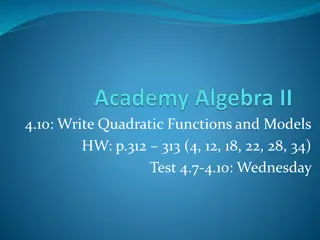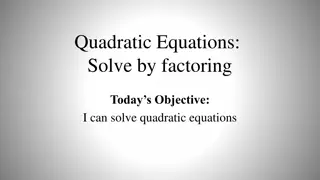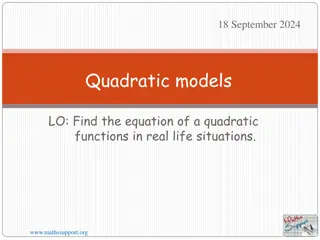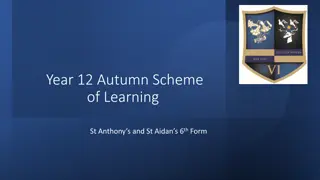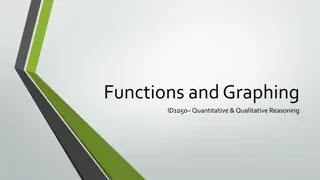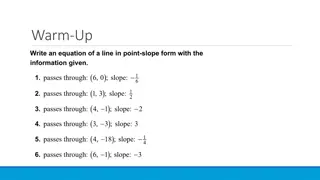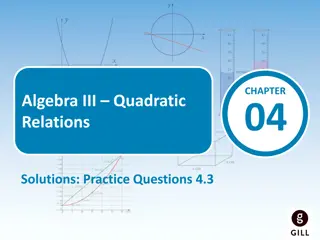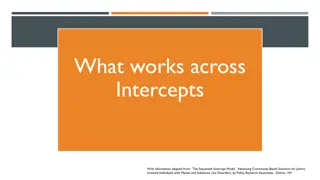Graphing Quadratic Functions: Using Intercept Form
Learn how to graph quadratic functions in the form f(x)=a(x-p)(x-q) using intercept form. Understand the impact of a, p, and q on the graph. Follow steps to determine direction, x-intercepts, vertex, and plot points for accurate graphing.
Download Presentation

Please find below an Image/Link to download the presentation.
The content on the website is provided AS IS for your information and personal use only. It may not be sold, licensed, or shared on other websites without obtaining consent from the author.If you encounter any issues during the download, it is possible that the publisher has removed the file from their server.
You are allowed to download the files provided on this website for personal or commercial use, subject to the condition that they are used lawfully. All files are the property of their respective owners.
The content on the website is provided AS IS for your information and personal use only. It may not be sold, licensed, or shared on other websites without obtaining consent from the author.
E N D
Presentation Transcript
8.5 Graphing Using Intercept Form 1. Students will be able to graph quadratic functions of the form f(x)=a(x-p)(x-q). 2. Students will be able to use intercept form to find zeros of functions. 3. Students will be able to use characteristics to graph and write quadratic functions. So we are looking at third and final way to graph parabolas.
1. Students will be able to graph quadratic functions of the form f(x)=a(x-p)(x-q). You have already graphed quadratic functions written in several different form, such as ? ? = ??2+ ?? + ? (standard form) and ? ? = ?(? )2+? (vertex form). Quadratic functions can also be written in intercept form, ? ? = ?(? ?)(? ?), where ? 0.
1. Students will be able to graph quadratic functions of the form f(x)=a(x-p)(x-q). Using DESMOS we will graph f(x)=a(x-p)(x-q). In the equation area type y=a(x-p)(x-q) (Notice it is xMINUSp and xMINUSq) Click the add slider for a,p and q Change the slider bounders to -5 to 5 with a step of 0.5 Now move the slider to see what happens to the graph
1. Students will be able to graph quadratic functions of the form f(x)=a(x-p)(x-q). Questions to answer. 1. Has what a does changed? No 2. So what is a doing? Determines which direction the parabola opens and the width. 3. What are p and q doing? Changes the x intercepts Remember when it is affecting the x it is the opposite of what you think!
1. Students will be able to graph quadratic functions of the form f(x)=a(x-p)(x-q). Steps to graphing ? ? = ?(? ?)(? ?) 1. Determine direction of parabola by looking at a. 2. The x intercepts are p and q. Plot 3. The AoS is halfway between the x intercepts ? =? + ? 2 4. Now find the vertex by plugging in the AoS. 5. Find another point by plugging in another x close to the AoS.
1. Students will be able to graph quadratic functions of the form f(x)=a(x-p)(x-q). Steps to graphing f(x)=a(x-p)(x-q). 1. Determine direction of parabola by looking at a. 2. The x intercepts are p and q. Plot 3. The AoS is halfway between the x intercepts ? =? + ? 2 4. Now find the vertex by plugging in the AoS. 5. Find another point by plugging in another point close to the AoS. Graph ?(?) = 2(? 3)(? + 1) 1. Opens up a > 0 2. x - intercept = 3 and -1 3. AoS: ? =3+( 1) 4. ? 1 = 2(1 3)(1 + 1) = 2( 2)(2) = 8 Vertex (1,-8) 5. Plug in another point x = 0 ? 0 = 2(0 3)(0 + 1) = 2 3 1 = 6 point = (0,-6) =2 2= 1 2
1. Students will be able to graph quadratic functions of the form f(x)=a(x-p)(x-q). Steps to graphing f(x)=a(x-p)(x-q). 1. Determine direction of parabola by looking at a. 2. The x intercepts are p and q. Plot 3. The AoS is halfway between the x intercepts ? =? + ? 2 4. Now find the vertex by plugging in the AoS. 5. Find another point by plugging in another point close to the AoS. Graph ? ? = (? + 6)(? 2) 1. Opens down a < 0 2. x - intercept = -6 and 2 3. AoS: ? = 6+2 2 4. ? 2 = ( 2 + 6)( 2 2) = (4)( 4) = 16 Vertex (-2,16) 5. Plug in another point x = 0 ? 0 = (0 + 6)(0 2) = 6 2 = 12 point = (0,12) = 4 2= 2
2. Students will be able to use intercept form to find zeros of functions. For any factor (? ?) of a polynomial, n is a zero of the function. For the factor (? 3), 3 is a zero of the function. For the factor (? + 5), -5 is a zero of the function. Find the zeros of the function. ? = (? 1)(?2 16) We can factor some more. ? = (? 1)(? + 4)(? 4) What are the zeros. ? = 1, 4,4
3. Students will be able to use characteristics to graph and write quadratic functions. Write a quadratic function in standard form whose graph satisfies the given condition(s). a) vertex: (-3,4) Because you know the vertex, use the vertex form ? ? = ?(? )2+? Since we are not told anything else about the quadratic we will assume a = 1 ? ? = (? + 3)2+4 ? ? = (? + 3)(? + 3) + 4 ? ? = ?2+ 3? + 3? + 9 + 4 ? ? = ?2+ 6? + 13
3. Students will be able to use characteristics to graph and write quadratic functions. b) Passes through (-9,0), (-2,0), and (-4,20) Since we are given the x intercepts, use the intercept form. ? ? = ?(? ?)(? ?) ? ? = ?(? + 9)(? + 2) Now we use the other point to find a ? 4 = ? 4 + 9 4 + 2 = 20 ? 5 2 = 20 ? 10 = 20 ? = 2 ? ? = 2(? + 9)(? + 2) ? ? = 2(?2+ 11? + 18) ? ? = 2?2 22? 36




